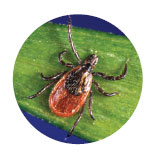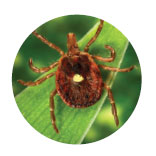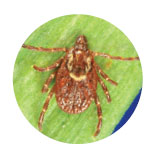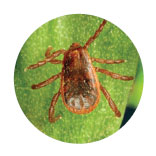0920-1150 HPWS Survey (mail)
Lyme and other Tickborne Diseases Knowledge, Attitude, and Practice Surveys
Attachment_1_HPWS Survey (Mail)
Knowledge, Attitudes, and Practices of Healthcare Professionals Working in Schools Regarding Tickborne Disease Prevention and Lyme Disease in New York State and Maryland
OMB: 0920-1150
Form Approved
OMB Control No.: 0920-1150
Expiration date: 12/31/2019
Healthcare Professionals Working in Schools (HPWS) Survey
We appreciate your time! The results from this survey will help us to better support you to prevent tickborne diseases in your students.
This survey is being conducted by the [insert EIP site] and the Centers for Disease Control and Prevention (CDC). Healthcare professionals working in schools in your state have been selected to participate.
The topic of this survey is prevention of tick bites and tickborne disease in the school setting. The survey questions will ask about your knowledge and school health practices as they relate to tickborne disease prevention.
This survey will take about 10 minutes. The survey is completely voluntary. You may decline to answer any question, and you can stop the survey at any time. All of the information that you give will be anonymous.
If you have any questions about this survey, we may be contacted by:
Email:
Phone:
Mail:
If you have any questions about your rights as a participant, please contact [insert EIP site] IRB Administrative Director at:
Email:
Phone:
Mail:
Please complete and return this survey using the envelope provided by [DATE].
Thank you for helping us to prevent tick bites and tickborne disease in school-aged children! ___________________________________________________________________________________
Eligibility Determination
Are you currently employed as a licensed healthcare professional that provides health services or consultation to students in a school setting?
Yes
No If “No,” please specify the reason below:
a) I am not currently employed
b) I am not a licensed healthcare professional
c) I do not provide health services or consultation to students in a school setting
d) I provide mental health services and counseling only
e) There is no licensed healthcare professional employed at this school
f) Other: ________________
If you selected “No,” you do not meet the eligibility criteria to complete this survey. Thank you for your time. Please mail the survey back in the envelope provided. We would be happy to provide you with FREE tickborne disease educational materials. If you are interested, please fill out the enclosed order form and include it in the envelope with your survey.
If you selected “Yes,” please answer the following questions based on your experience in the school setting. If you work in a school with more than one healthcare professional, answers should be based upon on your own individual experience, not the school setting as a whole.
Section I: General Demographics
This section contains questions that provide descriptive information about you and the school setting in which you work.
What is your current healthcare license?
Certified Nursing Assistant/Certified Medical Technician (CNA/CMT)
Licensed Practical Nurse (LPN)
Registered Nurse (RN)
Physician’s Assistant (PA)
Nurse Practitioner (NP)
Physician (MD, DO)
Other: ___________
Are you employed at a school-based health center?
Yes
No
In total, how long have you worked as a healthcare professional in a school setting as of the start of the 2018/2019 school year?
Less than 1 year
1-5 years
6-15 years
16-30 years
More than 30 years
At how many school sites do you work?
Number: _________
Approximately how many hours do you work in a typical workweek in the school setting?
Number: _________
What is the total number of students that you serve?
Less than 200 students
200 - 1,000 students
1,001 - 2,000 students
More than 2,000 students
What student populations do you serve? (Circle all that apply)
Preschool/Pre-Kindergarten
Elementary (example: Kindergarten - 5th)
Middle/junior high (example: 6th – 8th)
High school (example: 9th – 12th)
Other (please specify): _________________________
Section II: Knowledge Section
This section contains questions to assess your current knowledge of ticks and Lyme disease, since it is the most commonly reported tickborne disease in your state.
Which of the following images is the tick that can carry Lyme disease? (select only one)
-

a.

b.

c.

d.
e. Don’t know
About how long does an infected tick need to be attached to a person before transmission of the Lyme disease bacteria can occur?
Less than one hour
1-24 hours
Greater than 24 hours
Don’t know
How long does it take for erythema migrans (commonly referred to as the “bull’s eye rash”) of Lyme disease to develop after the bite of an infected tick?
Within a few hours after a tick bite
Within 2 days after a tick bite
3 to 30 days after a tick bite
31 to 60 days after a tick bite
Don’t know
What is the most common late stage symptom of Lyme disease (months after tick bite)?
Swollen joint(s)
Confusion
Erythema migrans (commonly referred to as “bull’s eye rash”)
Chest pain
Don’t know
True or False: A child who has previously had Lyme disease can get Lyme disease again if they are bitten by another infected tick.
True
False
Don’t know
True or False: In the case of a high-risk tick bite, a single prophylactic dose of antibiotic can be used to reduce the risk of acquiring Lyme disease.
True
False
Don’t know
Section III: Experiences and Practices
This section contains questions about your experiences and practices in your school setting related to ticks and tickborne disease.
Since the start of the 2018/2019 school year, how many times have you attended to a student for a suspected tick-related issue?
None
1-5 times
6-15 times
16-30 times
31-50 times
More than 50 times
Does your school have a policy regarding the removal of ticks from students?
Yes
No
Don’t know
In your practice in the school setting, are you allowed to remove attached ticks from students?
Yes
No
Don’t know
Since the start of the 2018/2019 school year, approximately how many ticks have you removed from students?
None-I’m not allowed to remove attached ticks from students
None-No students presented with attached ticks
1-5 ticks
6-15 ticks
16-30 ticks
31- 50 ticks
More than 50 ticks
I don’t know
In your practice in the school setting, how do you remove an attached tick? (Circle all that apply)
Apply fingernail polish
Cover with a cotton ball soaked in rubbing alcohol
Grasp the mouthparts of the tick with fine tip tweezers & gently pull it out
Smother the tick with petroleum jelly such as Vaseline
I don’t remove attached ticks
Other: _________________________
What do you do for a student who has had a tick bite? (Circle all that apply)
Send the student home
Tell the student to be alert for fever and rash
Contact the parents/guardians
Contact the student’s primary care provider
Offer educational resources on tick bite prevention
Recommend antibiotics to prevent Lyme disease
Recommend Lyme disease testing for the student
Recommend that the tick be tested for evidence of infection
None of the above
Other: __________________________
Do you attempt to identify ticks?
Yes
No (Please skip the next question)
If yes, how do you go about identifying a tick? (Circle all that apply)
Submit to a laboratory for identification
Ask a colleague
Contact the department of health
CDC website
Internet search engine (e.g. Google)
Tick ID card
Other (please specify): _______________________________
In your current role, have you given a presentation on tickborne diseases at the school?
Yes
No
Does not apply to me
Section IV: Prevention
This section contains questions about your recommendations to students to prevent tick bites and resources provided to students.
Do you talk with individual students about their risk for tick bites and ways to protect themselves from being bitten?
Yes
No
If
“No,” is this done by another staff member or individual
at the school?
a) Yes
b) No
c) Don’t know
What do you recommend to students to prevent tick bites? (Circle all that apply)
Use an EPA-registered insect repellent on skin or clothes
Wear light colored clothes when outside in wooded or grassy areas
Check for ticks, especially after being outdoors
Shower soon after being outdoors
Change clothes after being outdoors
Tumble dry clothes in the dryer for at least 10 minutes after coming in from outdoors
Avoid tick habitat (such as thick brush and tall grass)
Wear clothing treated with permethrin
I do not provide recommendations to students to prevent tick bites
Other (please specify): _________________________________________
Do you routinely send home health-related educational resources with students? (i.e. pamphlets, flyers, informational booklets)
Yes
No
Does not apply to me
Do you send home tickborne disease-related educational resources with students?
Yes
No
Does not apply to me
Do you know where you can obtain educational resources for students on tick bite and tickborne illness prevention? (i.e. pamphlets, flyers, informational booklets)
Yes
No
Section V: Attitudes and Perception
This section contains questions to assess your perception of risk for tickborne disease in your student population and your degree of confidence in addressing concerns related to ticks and tickborne disease.
How high do you believe the risk is for students in your community for getting a tickborne disease?
No risk
Low risk
Medium risk
High risk
In general, I feel ____________ about my ability to determine how long a tick has been attached to a person.
Not at all confident
A little confident
Moderately confident
Very confident
In general, I feel ____________ about my ability to remove a tick that is attached to a person.
Not at all confident
A little confident
Moderately confident
Very confident
In general, I feel ____________ about my ability to recognize the symptoms of Lyme disease.
Not at all confident
A little confident
Moderately confident
Very confident
Section VI: Resource Information
This section contains questions on where you obtain information and educational materials on ticks and Lyme disease.
Are you familiar with the New York State Education Department curriculum titled “Tick and Tick-borne Disease Resource Toolkit” that contains information on tickborne disease prevention, including sample education strategies?
Yes
No
Have you ever received specific education about tickborne disease prevention for a school setting?
Yes
No
Don’t know
Which of the following are your top three sources of information about Lyme disease? (Please circle your top 3)
Professional societies (e.g. AAFP, AAP, IDSA, etc.)
Professional journals
Medical conferences
State or local health department
My school district
Federal organizations (e.g. CDC, NIH)
Television or radio
Newspapers or magazines
Friends and family
Professional colleague (e.g. other school-based healthcare professional)
Other healthcare providers
Other (please specify): ___________________________________________
Which of the following are your top three online sources for information about Lyme disease? (Please circle your top 3)
Online medical advising group (e.g. WebMD, Mayo Clinic, Medscape)
Federal organizations (e.g. CDC, NIH)
State or local health department
Social media (e.g. Facebook, Twitter, etc.)
Google search (or other search engine)
Online blogs
YouTube
Lyme disease specialty website (e.g. ILADS, Lyme Disease Association, etc.)
I don’t use online sources for information about Lyme disease
Other (please specify): _____________________________________________
Which of the following resources about tick bites and tickborne disease prevention would be helpful to you in your school health services program? (circle all that apply)
Paper resources (informational pamphlets, brochures, flyers, posters)
Online resources (PowerPoints, PDFs, Audio/visual web sessions)
Regular email updates
In-person meetings/trainings
Other (please specify):_____________________________________________
Would continuing education credits increase your willingness to participate in education for tickborne disease prevention?
Yes
No
Does not apply to me
What, if any, barriers do you face in utilizing educational resources on tick bite and tickborne disease prevention? (Free text response)
________________________________________________________________________________________________________________________________________________________________________
What more would you like to learn about Lyme disease, ticks, and/or tickborne diseases? (Free text response) ________________________________________________________________________________________________________________________________________________________________________
Is there anything else that you think we should know about? (Free text response)
________________________________________________________________________________________________________________________________________________________________________
Thank you for your time today! Your responses will help us learn how to better support you and your school in the prevention of tickborne diseases. Please mail the survey back in the envelope provided.
We would be happy to provide you with FREE tickborne disease educational materials. If you are interested, please fill out the enclosed order form and include it in the envelope with your survey.
For more information about ticks and Lyme disease, please consider these additional resources:
CDC tickborne disease website: https://www.cdc.gov/ticks/
CDC Lyme disease website
[Insert EIP site] Dept. of Health Lyme disease websites
New York State Center for School Health Tick and Tickborne Disease Webpage
Public reporting burden of this collection of information is estimated to average 10 minutes per response, including the time for reviewing instructions, searching existing data sources, gathering and maintaining the data needed, and completing and reviewing the collection of information. An agency may not conduct or sponsor, and a person is not required to respond to a collection of information unless it displays a currently valid OMB Control Number. Send comments regarding this burden estimate or any other aspect of this collection of information, including suggestions for reducing this burden to CDC/ATSDR Reports Clearance Officer, 1600 Clifton Road NE, MS D-74, Atlanta, Georgia 30333; ATTN: PRA 0920-1150
| File Type | application/vnd.openxmlformats-officedocument.wordprocessingml.document |
| File Modified | 0000-00-00 |
| File Created | 0000-00-00 |
© 2025 OMB.report | Privacy Policy